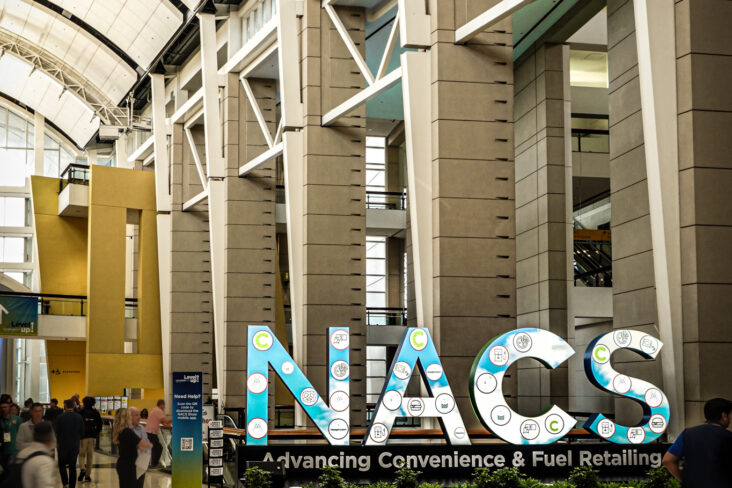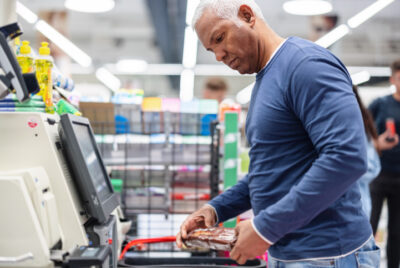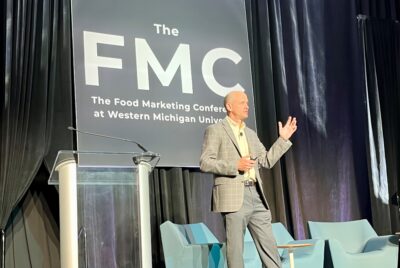The future of convenience isn’t at the pump but inside the store. That was how Chris Rapanick, Managing Director of NACS Research, started his State of the Industry masterclass during NACS 2025.
Spread across three days at Chicago’s McCormick Place Convention Center, the conference brought together suppliers, operators and service providers from across the country—and all over the world—to share best practices, collaborate on new ideas and spur innovation. With over 24,000 attendees and 1,200 exhibitors in attendance, NACS 2025 showcased the people and ideas driving the convenience channel forward.
From emerging product trends and the evolving role of technology to the importance of community, here’s what stood out at this year’s event.
Value and Values
Price still matters, but in the face of inflation and tariffs, many consumers are prioritizing a seamless and stress free shopping experience.
While C-stores need to execute on the basics—item availability, store layout, cleanliness—shoppers increasingly seek a holistic experience built around exceptional service and personal connection.
“You might go to a grocery store every week or two, but there are people who visit their local C-store several times a week, possibly even more than once a day,” explained Doug Middlebrooks, Sr. Vice President of Convenience Channel Sales for Advantage Solutions. “Even if you’re in and out within a minute, it’s a different experience when the person behind the counter asks after your family or has your favorite candy bar waiting for you.”
This blend of efficiency and familiarity is what sets convenience stores apart in today’s competitive retail landscape, especially when the trip is part of a daily routine.
Powering Up
When it comes to consumer purchasing, protein still packs a punch, but energy drinks are fueling sales, especially in the morning.
Packaged beverage is the top category for C-stores according to NACS, representing over 34% of all in-store transactions. At a time when other categories like cigarettes, beer and salty snack sales are declining, packaged beverage has seen over 2.5% year-over-year sales growth while maintaining one of the highest gross margins inside the store.
Within the category, energy drinks stand out as a top performer, with estimates citing almost one-third of purchases within packaged beverage. Whether it’s caffeine, taurine, B-vitamins, amino acids, ginseng, sugar and its derivatives, or all of the above, there are a seemingly infinite number of options for how to power your day. New flavor combinations, vibrant packaging and compelling can artwork add to the experience.
The rise in GLP-1 usage continues to show strong demand for high-protein, low-sugar, grab-and-go options. Although protein bars, jerky, meat sticks and yogurt are still coming off the shelf at a fast rate, they are not driving growth so much as buoying year-over-year trends.
As C-stores adapt to shifting consumer priorities, expect continued innovation in energy and protein-forward offerings. It wouldn’t be surprising to see even more crossover between the two soon.
Convenience at your Fingertips
AI is driving countless innovation behind the scenes at C-Stores. Modeling inventory, recruiting with HR agents and using facial recognition for everything from demographics to identifying repeat shoplifters are just some of the applications being implemented. Pairing algorithms with hardware, such as MIT’s early-smell detection research, may become standard in the not-too-distant future.
While AI continues to make the splashiest headlines, new hardware and software are quietly transforming the speed, efficiency and quality of customer purchases within the store.
For consumers on the go, here are some of our favorites from the show:
- Barista in a box: The days of customers fueling up and then driving across the street for a cup of coffee are starting to wane. Many new options allow operators to offer a quick, high-quality, made-to-order cup of freshly ground coffee. New systems even offer a compact nitro cold brew system at the pull of a tap.
- Keeping up with kiosks: No one likes waiting in line, so providing a streamlined way to order that allows for personalization is a win-win. Initial returns show that highlighting potential add-ons, combos, and premium options lead to larger orders through more effectively up-selling and cross-selling.
- Speedier self check-out: Say goodbye to individual scanning. This new technology allows users to place all their items on a table, which calculates the total in real time. Not only does this make it easier for the shopper, it also allows store personnel to focus on the person in front of them instead of transactional interactions.
Focus on Foodservice
With several mainstay categories such as tobacco and fuel in decline, food showed year-over-year growth and accounted for almost 30% of in-store sales in 2024. While larger, more established programs aim to compete with quick service restaurants and further differentiate their brand, not all stores have the space, budget or personnel to do so.
Pre-packaged, ready-to-eat items like sandwiches, wraps and salads accounted for over a quarter of foodservice revenue in 2024. They offer operators a scalable way to meet growing consumer demand for fresh, grab-and-go options without the labor and operational complexity of on-site food prep. For shoppers, the availability of better-for-you options paired with speed and convenience is a win-win.
As commissary continues to mature in the United States, Japan provides a glimpse into what it could soon become. Konbiniensu sutoru, which directly translates as convenience store, ensure their shelves are constantly stocked with fresh options by receiving upwards of three deliveries of perishable items per day. These konbini, as they’re known, use this just-in-time approach to maintain peak freshness while reducing waste.
What Sets Convenience Apart
From functional food and emerging technologies to elevated customer experiences, C-stores are evolving from fuel stops into high-speed, high-quality trips that increasingly exist as a third space for the community. As sales in traditional categories like gas, tobacco and alcohol continue to decline, the channel is redefining its role, offering more value, more innovation and more connection than ever before.
During a general session on leadership, current NACS President and CEO Henry Armour emphasized how C-stores are different from other retail. He spoke to how Convenience is a place where competitors are willing to partner for the common good, support their customers, support their communities and shape the future of the channel together.




